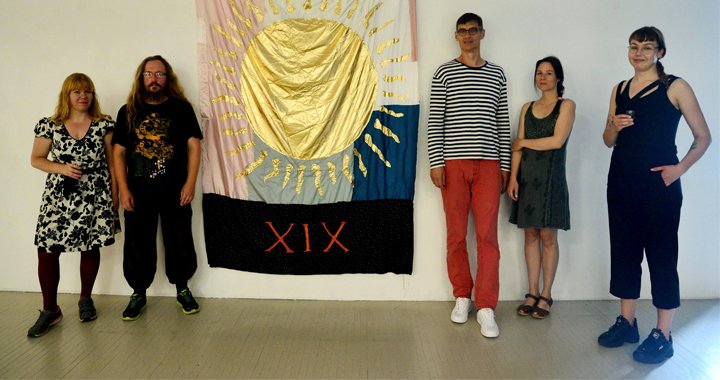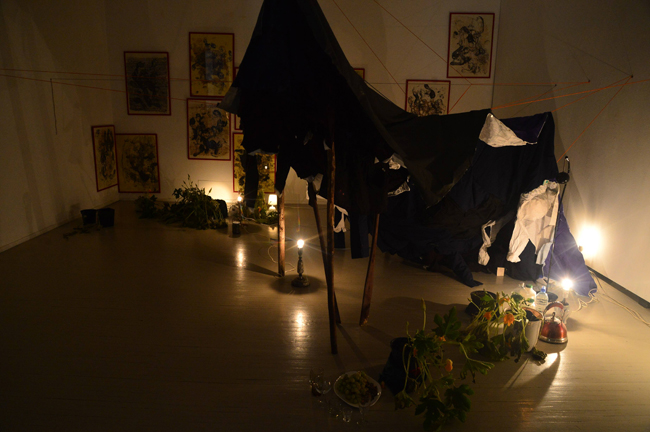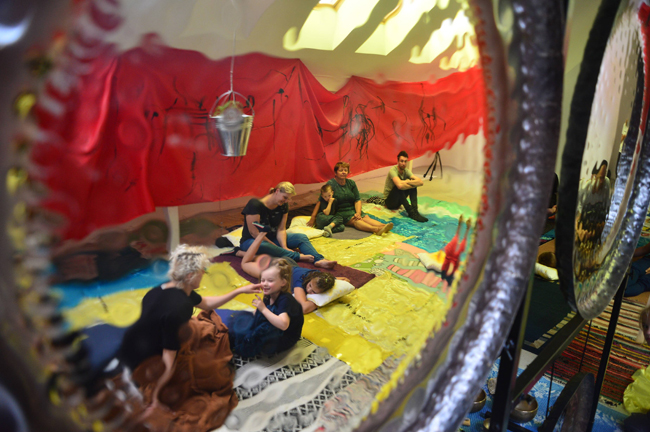
Nomadic Radical Academy for the Climate Change Awareness
Marija Griniuk & Tue Brisson Mosich
15/08/2019
Photo: Antanas Untydi
If one happens to step into the gallery “Meno Parkas” (Rotušės a. 27, Kaunas, Lithuania) in August 2019, one steps into the Nomadic Radical Academy for Climate Change Awareness.
The Nomadic Radical Academy is an art project which takes the form of live performance as an immersive artistic vision of the post-apocalyptic world, where the remaining humans can not undo their mistakes anymore. As future nomads, the workers and inhabitants of the academy will set down their tent poles and invite local children and youths to view, sense, discuss and participate with the resident artists, musicians and climate change activists and together uncover past and future scenarios of human behavior, the environment and the planet we inhabit.
Reindeer and Nomadic Artists

The idea for this art project was born north of the Arctic Circle in the Abisko Scientific Research Center where one of the initiators of the project (Marija Griniuk) spent a workshop-residency time last winter. In the area close to the mountains called the Gate to Lapland, the reindeer herders struggle with the problem of their reindeer not being able to find enough food, the reindeer are otherwise very well adapted to the harsh winters. Their fur is a dense layer of wool. Yet, each year the reindeer need more and more help foodwise in order to survive the winter and food is supplemented by the herders to prevent starvation. This is one of many signifiers of climate change on our planet physically felt by humans and animals living close to the arctic circle. As an artist and researcher behind the project, I (Marija Griniuk) am currently based both in Lithuania and the Finnish part of Lapland. As an artist I seek sustainable ground to realise the projects which are urgent for the contemporary spectator. Seeking sustainable ground does not necessarily result in finding it and I, as well as the reindeer, find myself navigating throughout the most northern part of Europe. The reindeer are the Nomads. As well are contemporary artists.
According to The Guardian, we have 12 years to undo the climate change catastrophe on our planet.[1] What can we do as activists? What can we do as the artists? What can we do as humans?
The Nomadic Radical Academy

The Nomadic Radical Academy is a way of creating a community of artists and/or climate change activists in order to discuss new ways of re-thinking human behavior in the environment we live in. The first iteration of the project is happening in Lithuania and the Radical Academy is nomadic due to plans to manifest it in art venues of major cities in the Nordic-Baltic region.
The Nomadic Radical Academy for the Climate Change Awareness is a post-apocalyptic shanty-town in the gallery space where artists, musicians and the climate change activists are “living” in tents and shelters. Together with the participants of this project the involved facilitators uncover past and future scenarios of the human behavior in the environment.
This shanty-town is in the format of the artistic camp for children and youth. We aim to bring the families together in order to create a common space for discussion which possibly will go beyond the community of one family only. In other words we spread the message and we hope for the continuation of the discussions between us, as artists; between participants and their circles of communication. We include both sensuous experience and the concrete narrative based decisions where we discuss the issues on how can we think and behave differently. All the sessions are for the groups of participants. In each session participates one focus-facilitator: an artist, a musician or a climate change expert. The sensuous meditative sessions are with natural materials, recycled materials, recorded and live sounds from and in the surroundings of the physical gallery space. This part is a metaphoric message of the distances between us, the humans; between human and nature.
The project is realised in the format of the day-camp, during which one can participate in performances, workshops, discussions, collective food cooking and collective dinners. The project is free of charge for the participants and this is an important aim in giving equal possibility for all interested to be involved. The regular visitors of the gallery may come as viewers of the art project. TheNomadic Radical Academy is a project built on the ideas of InterMedia[2] from Fluxus Pedagogies. We work with the activation of the senses while teaching and learning, combining traditional installation space at a gallery, climate change awareness with performative pedagogy. Within the creative spaces of our art installation children integrate and interpret art; develop their critical thinking in the contemporary global environmental consciousness; raise their awareness of the necessity of changing our behaviour in the environment; by artistic means join the activists in understanding the climate change problem and its consequences for the Earth and humans; discuss their identity in a global society and critically look at information which is given in the media on this topic. We want to encourage children to broaden their horizons by working with art and using the prism of art to discuss the socio-cultural environment and our role and identity in it.
Ethical and practical challenges

We found that an artistic project with a focus on climate change and sustainability faces a number of challenges. Not least of which is the perhaps altogether too common problem of a lack of funding.
This has led to all participants working as volunteers, which is of course not sustainable. And counterintuitive as it may be, flying someone in from abroad is usually cheaper than by e.g. train. When funding fell through, we tried for local sponsorships, also with little luck, from e.g. DIY stores, where we would have been happy with, even preferred, any defective materials they might have.
Thus in the end we have ended up relying on self-investment and voluntary donations, and instead of reusing/recycling materials, we have to buy used or even new ones. There is also the fact, that once preparations are in progress, the closer the deadline, the harder it seems to be to cancel a project.
At all these junctions we have had to examine the potential ‘good’ vs. ‘bad’ of the project, but these things are not easily quantifiable. What is an idea or thought worth compared to the pollution of a flight trip? And is this a battle of actions and bodies or for minds and ideas?
The biggest problems and challenges thus become our limited capability to provide solutions to all these problems and still maintaining an openness (ie. free of charge access) to everyone interested. Being open-access we have the other end unsolved - facilitating all the ecologically and ethically clean nuances of this project for the participants.
How to save the planet as an artist

So how to save the planet as an artist? We would like to give a concise answer, but find ourselves unable to. The unwritten rules of the realization of the artistic projects are clashing with ideals of ethical and eco-friendly behaviour as individuals. Most current lifestyle normatives are in conflict with what is expected from the human who is saving the planet.
Would we even want to turn back the clock on globalization? The increasing necessity of intense artistic work logistically located in multiple countries or continents does not go hand in hand with environmentally problematic (cheap) flights, and unaffordable electrical cars are most likely not those which most artists are using to transport their works to the exhibition venues.
Which ends justify what means? In the end, we (humans) are fighting only for and against ourselves. The planet is uncaring as to what walks and grows upon it; what life infests it. Before humans even could inhabit the world, other organisms were plentiful and shaped the world for us. If it is any consolation, long after societies, capitalism and art has gone extinct, the Earth will still be in its orbit and the Sun will still shine upon it.
Who, what, where

The participants of the Nomadic Radical Academy for the Climate Change Awareness are the following Europe-based artists: the artist-researcher behind the project Marija Griniuk (LT/DK/FIN), the involved artists: Tue Brisson Mosich (DK/LT), Nanna Ylönen (FIN), Clifford Charles (UK), Marta Gil (SE), Sanna Blennow (SE), Rikke Goldbech (DK), David Torstensson (SE), Anne-Louise Knudsen (DK), Anders Werdelin (DK), Adomas Danusevičius (LT/DK) and the Kaunas-based Lithuanian artists and initiatives: Evelina Šimkutė, Šilainių Sodai, Vyrenijus Andrijauskas along with others. Video documentation of the project: Albinas Liutkus. Photo documentation of the project: Antanas Untydi.
[1] https://www.theguardian.com/environment/2018/oct/08/global-warming-must-not-exceed-15c-warns-landmark-un-report
[2] Andersen, Eric. “What is…?” in The Fluxus Constellation, edited by Sandra Solimano, Neos Edizioni, 2002.